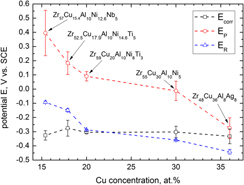Crossref Citations
This article has been cited by the following publications. This list is generated based on data provided by
Crossref.
Gostin, Petre Flaviu
Eigel, Dimitri
Grell, Daniel
Uhlemann, Margitta
Kerscher, Eberhard
Eckert, Jürgen
and
Gebert, Annett
2015.
Stress corrosion cracking of a Zr-based bulk metallic glass.
Materials Science and Engineering: A,
Vol. 639,
Issue. ,
p.
681.
Gostin, Petre
Eigel, Dimitri
Grell, Daniel
Uhlemann, Margitta
Kerscher, Eberhard
Eckert, Jürgen
and
Gebert, Annett
2015.
Stress-Corrosion Interactions in Zr-Based Bulk Metallic Glasses.
Metals,
Vol. 5,
Issue. 3,
p.
1262.
Grell, Daniel
Gostin, Petre Flaviu
Eckert, Jürgen
Gebert, Annett
and
Kerscher, Eberhard
2015.
In Situ Electrochemical Analysis during Deformation of a Zr‐Based Bulk Metallic Glass: A Sensitive Tool Revealing Early Shear Banding.
Advanced Engineering Materials,
Vol. 17,
Issue. 11,
p.
1532.
Zhao, Guo-Hua
Aune, Ragnhild E.
Mao, Huahai
and
Espallargas, Nuria
2016.
Degradation of Zr-based bulk metallic glasses used in load-bearing implants: A tribocorrosion appraisal.
Journal of the Mechanical Behavior of Biomedical Materials,
Vol. 60,
Issue. ,
p.
56.
Tang, Junlei
Zhu, Qiuhong
Wang, Yingying
Apreutesei, Mihai
Wang, Hu
Steyer, Philippe
Chamas, Mohamad
and
Billard, Alain
2017.
Insights on the Role of Copper Addition in the Corrosion and Mechanical Properties of Binary Zr-Cu Metallic Glass Coatings.
Coatings,
Vol. 7,
Issue. 12,
p.
223.
Grell, Daniel
Wilkin, Yannic
Gostin, Petre F.
Gebert, Annett
and
Kerscher, Eberhard
2017.
Corrosion Fatigue Studies on a Bulk Glassy Zr-Based Alloy under Three-Point Bending.
Frontiers in Materials,
Vol. 3,
Issue. ,
Qiu, Zhang-wei-jia
Fu, Hua-meng
Zhang, Hong-wei
Li, Hong
Li, Zheng-kun
Zhang, Long
Zhu, Zheng-wang
Wang, Ai-min
and
Zhang, Hai-feng
2018.
Effects of Ti addition on corrosion behavior of Zr-based metallic glass in chloride medium.
Journal of Iron and Steel Research International,
Vol. 25,
Issue. 6,
p.
650.
Liu, Jingbei
Liu, Naijia
Sun, Meng
Li, Jinyang
Sohn, Sungwoo
and
Schroers, Jan
2019.
Fast Screening of Corrosion Trends in Metallic Glasses.
ACS Combinatorial Science,
Vol. 21,
Issue. 10,
p.
666.
Geissler, D.
Uhlemann, M.
and
Gebert, A.
2019.
Catastrophic stress corrosion failure of Zr-base bulk metallic glass through hydrogen embrittlement.
Corrosion Science,
Vol. 159,
Issue. ,
p.
108057.
Deng, L.
Gebert, A.
Zhang, L.
Chen, H.Y.
Gu, D.D.
Kühn, U.
Zimmermann, M.
Kosiba, K.
and
Pauly, S.
2020.
Mechanical performance and corrosion behaviour of Zr-based bulk metallic glass produced by selective laser melting.
Materials & Design,
Vol. 189,
Issue. ,
p.
108532.
Liens, Aléthéa
Ter-Ovanessian, Benoît
Courtois, Nicolas
Fabregue, Damien
Wada, Takeshi
Kato, Hidemi
and
Chevalier, Jérôme
2020.
Effect of alloying elements on the microstructure and corrosion behavior of TiZr-based bulk metallic glasses.
Corrosion Science,
Vol. 177,
Issue. ,
p.
108854.
Gebert, Annett
Geissler, David
Pilz, Stefan
Uhlemann, Margitta
Davani, Farnaz A.
Hilke, Sven
Rösner, Harald
and
Wilde, Gerhard
2020.
Studies on Stress Corrosion Cracking of Vit 105 Bulk Metallic Glass.
Frontiers in Materials,
Vol. 7,
Issue. ,
Zhong, Wen
Ren, Yanan
Hu, Jing
and
Xiang, Huiyu
2020.
Normal stress effect on plastic yielding of notched metallic glass: a finite element simulation study.
Materials Research Express,
Vol. 7,
Issue. 1,
p.
016570.
Meng, Mengmeng
Li, Ran
Zuo, Lei
Luo, Xuekun
and
Zhang, Tao
2021.
Fabrication of hierarchical porous metallic glasses decorated with Cu nanoparticles as integrated electrodes for high-performance non-enzymatic glucose sensing.
Scripta Materialia,
Vol. 199,
Issue. ,
p.
113884.
Jiang, J.
Wang, Z.B.
Pang, S.J.
Zheng, Y.G.
and
Li, Y.
2021.
Oxygen impurity improving corrosion resistance of a Zr-based bulk metallic glass in 3.5 wt% NaCl solution.
Corrosion Science,
Vol. 192,
Issue. ,
p.
109867.
Gu, Jia-Lun
Lu, Si-Yuan
Shao, Yang
and
Yao, Ke-Fu
2021.
Segregating the homogeneous passive film and understanding the passivation mechanism of Ti-based metallic glasses.
Corrosion Science,
Vol. 178,
Issue. ,
p.
109078.
Zhang, Peilei
Tan, Jie
Tian, Yingtao
Yan, Hua
and
Yu, Zhishui
2022.
Research progress on selective laser melting (SLM) of bulk metallic glasses (BMGs): a review.
The International Journal of Advanced Manufacturing Technology,
Vol. 118,
Issue. 7-8,
p.
2017.
Jiang, J.
Wang, Z.B.
Zheng, Y.G.
and
Li, Y.
2023.
Effect of oxygen impurity on corrosion behavior of a Zr-based bulk metallic glass in 0.5 M H2SO4 and 0.5 M NaOH solutions.
Materials Letters,
Vol. 330,
Issue. ,
p.
133231.
Fernández-Navas, Nora
Shtefan, Viktoriia
Hantusch, Martin
and
Gebert, Annett
2024.
Acid Treatments of Ti-Based Metallic Glasses for Improving Corrosion Resistance in Implant Applications.
Metals,
Vol. 14,
Issue. 2,
p.
241.
Tiwari, Kirti
Blanquer, Andreu
Pavan, Cristina
Tomatis, Maura
Navas, Nora Fernandez
Scaglione, Federico
Fiore, Gianluca
Turci, Francesco
Nogués, Carme
and
Rizzi, Paola
2024.
Surface modification of Ti40Cu40Zr11Fe3Sn3Ag3 amorphous alloy for enhanced biocompatibility in implant applications.
Journal of Materials Research and Technology,
Vol. 30,
Issue. ,
p.
2333.





